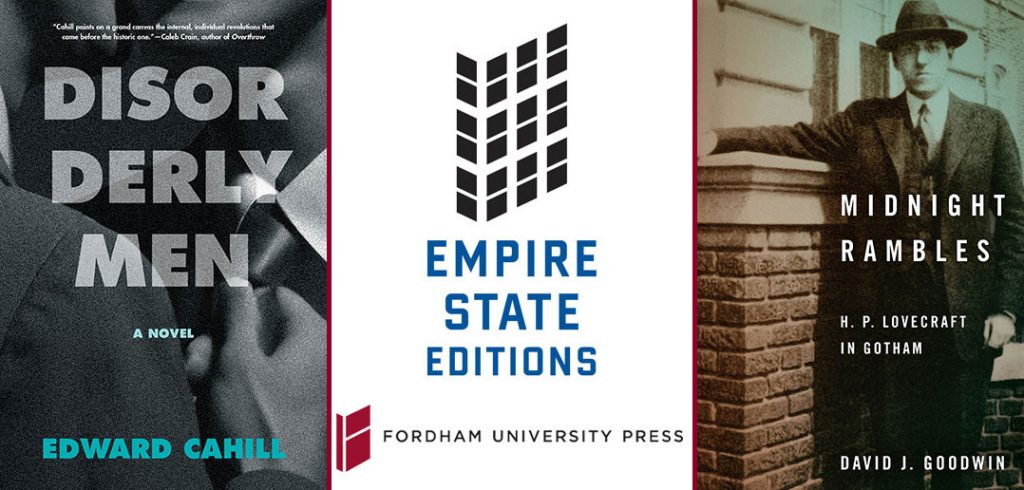A selection of recent titles from Fordham University Press
Disorderly Men: A Novel
 In Disorderly Men, Fordham English professor Edward Cahill evokes New York City in the mid-20th century, several years before the 1969 Stonewall uprising catalyzed the movement for LGBTQ+ rights. The novel opens with a police raid on Caesar’s, a mob-owned gay bar in Greenwich Village, where Roger Moorehouse, a Wall Street banker and World War II veteran with a wife and children in Westchester, was about to leave with “the best-looking boy” in the place. “Fragments of his very good life—the fancy new office overlooking lower Broadway, the house in Beechmont Woods, Corrine and the children—all presented themselves to his imagination as fitting sacrifices to the selfish pursuit of pleasure,” Cahill writes.
In Disorderly Men, Fordham English professor Edward Cahill evokes New York City in the mid-20th century, several years before the 1969 Stonewall uprising catalyzed the movement for LGBTQ+ rights. The novel opens with a police raid on Caesar’s, a mob-owned gay bar in Greenwich Village, where Roger Moorehouse, a Wall Street banker and World War II veteran with a wife and children in Westchester, was about to leave with “the best-looking boy” in the place. “Fragments of his very good life—the fancy new office overlooking lower Broadway, the house in Beechmont Woods, Corrine and the children—all presented themselves to his imagination as fitting sacrifices to the selfish pursuit of pleasure,” Cahill writes.
Also caught up in the raid are Columbia University professor Julian Prince and his boyfriend, Gus, a “serious-minded painter” from Wisconsin who gets knocked unconscious by a police baton; and Danny Duffy, a Bronx kid who helps manage the produce department at Sloan’s Supermarket. They’re charged with “disorderly behavior,” and their lives are upended—Roger is threatened by a blackmailer, Danny loses his job and family and seeks revenge, and Julian searches for Gus, who goes missing.
Cahill depicts their crises with pathos, humor, and suspense. And like the best historical fiction, Disorderly Men not only evokes a bygone era but also feels especially vital today.
Midnight Rambles: H. P. Lovecraft in Gotham
 The cult writer H. P. Lovecraft was not well known during his lifetime, most of which he spent in his native Providence, Rhode Island. But the so-called weird fiction he wrote in the 1920s and 1930s—a blend of horror, science fiction, and myth—has “entranced readers” and influenced artists in various media ever since, David J. Goodwin writes in Midnight Rambles.
The cult writer H. P. Lovecraft was not well known during his lifetime, most of which he spent in his native Providence, Rhode Island. But the so-called weird fiction he wrote in the 1920s and 1930s—a blend of horror, science fiction, and myth—has “entranced readers” and influenced artists in various media ever since, David J. Goodwin writes in Midnight Rambles.
From shows like Netflix’s Stranger Things to the films of Academy Award-winning director Guillermo del Toro to the novels of Stephen King and beyond, artists have been inspired by Lovecraft’s “vivid world-building and bleak cosmogony.” They’ve also been repulsed by his racist and xenophobic views.
Goodwin, the assistant director of Fordham’s Center on Religion and Culture, deals with this head-on in Midnight Rambles, a chronicle of the writer’s love-hate relationship with New York and the city’s effect on him and his writing. He describes the brief period—from 1924 to 1926—when Lovecraft lived in Brooklyn, drawn there by Sonia Greene, a Ukrainian Jewish émigré he met at a literary convention in Boston. Their marriage soon fell apart, and he moved back to Providence, where he died in 1937 at age 46. “An extended encounter with a great city reveals and exaggerates the strengths, foibles, attributes, and flaws of a character in a film or a person in the flesh-and-blood world,” Goodwin writes. “This is certainly true of Lovecraft and his years in New York City.”

